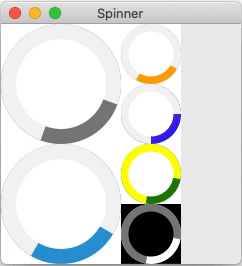New issue
Have a question about this project? Sign up for a free GitHub account to open an issue and contact its maintainers and the community.
By clicking “Sign up for GitHub”, you agree to our terms of service and privacy statement. We’ll occasionally send you account related emails.
Already on GitHub? Sign in to your account
Support for spinner-like widget in glimmer-dsl-libui? #20
Comments
|
You can simply implement a I added a section to the README called Area Animation that documents how to do it. Spinner example that has a fully customizable method-based custom control called require 'glimmer-dsl-libui'
class SpinnerExample
include Glimmer
SIZE = 120
def initialize
create_gui
end
def launch
@main_window.show
end
def create_gui
@main_window = window {
title 'Spinner'
content_size SIZE*2, SIZE*2
horizontal_box {
padded false
vertical_box {
padded false
spinner(size: SIZE)
spinner(size: SIZE, fill_color: [42, 153, 214])
}
vertical_box {
padded false
spinner(size: SIZE/2.0, fill_color: :orange)
spinner(size: SIZE/2.0, fill_color: {x0: 0, y0: 0, x1: SIZE/2.0, y1: SIZE/2.0, stops: [{pos: 0.25, r: 204, g: 102, b: 204}, {pos: 1, r: 2, g: 2, b: 254}]})
spinner(size: SIZE/2.0, fill_color: :green, unfilled_color: :yellow)
spinner(size: SIZE/2.0, fill_color: :white, unfilled_color: :gray, background_color: :black)
}
}
}
end
def spinner(size: 40.0, fill_color: :gray, background_color: :white, unfilled_color: {r: 243, g: 243, b: 243}, donut_percentage: 0.25)
arc1 = arc2 = nil
area { |the_area|
rectangle(0, 0, size, size) {
fill background_color
}
circle(size/2.0, size/2.0, size/2.0) {
fill fill_color
}
arc1 = arc(size/2.0, size/2.0, size/2.0, 0, 180) {
fill unfilled_color
}
arc2 = arc(size/2.0, size/2.0, size/2.0, 90, 180) {
fill unfilled_color
}
circle(size/2.0, size/2.0, (size/2.0)*(1.0 - donut_percentage)) {
fill background_color
}
on_mouse_up do
the_area.destroy
end
}.tap do
Glimmer::LibUI.timer(0.05) do
delta = 10
arc1.start_angle += delta
arc2.start_angle += delta
end
end
end
end
SpinnerExample.new.launchAs you can see, the If you click on any of the spinners, they are destroyed. This is how you can remove them in your application once there is no more work to do that needs a spinner, by calling the To add them, you simply call code like this (assuming you declared a
BTW, it works on Windows too: Also, it works on Linux: If there is anything that is not clear enough or you have any further questions, feel free to ask me by replying to this issue (even if closed) or opening a new one if needed. Cheers! |



Hey there Andy,
I already wrote a proposal for libui-ng in regards to spinner-widgets.
In ruby-gtk3 the spinner widget can be used to indicate an activity is ongoing.
See here as an example for the spinner in gtk:
https://docs.gtk.org/gtk4/class.Spinner.html
I use this, for example, to a GUI where the user can modify meta-data
of a .mp4 file, via ffmpeg. That part works fine.
Now I was thinking to make this available on windows too. ffmpeg.exe
works on windows, I already know that.
So my idea was to use glimmer-dsl-libui for that. But as far as I am aware
there is no spinner functionality in upstream libui. Would it be possible to
simulate or fake such a spinner widget, in glimmer-dsl-libui?
I don't have a good way to propose this, but two ideas I have on the top
of my head are:
specify delay set. This could be a button too but need not necessarily
be; could be a box container that just shows an image.
or alternatively:
or something like that. Then, like every "tick", say 0.3 seconds or something
like that, it could be redrawn a bit to indicate rotation (activity). This can
be a super-simple circle too, perhaps perfect-shape allows for partial
colour fills. Then we could say the upper top right quadrant is red,
when before it black. Then the lower right quadrant colour is red, and
the upper top right is now black again, and so forth. So in other words
to fake a spinner-like widget.
Does not have to look pretty. The main idea behind the spinner is to
indicate to the user that the application is still working, so the user does
not get bored and knows that things are still happening as-is.
I don't know how easy it would be for glimmer-dsl-libui to support it or
whether you think it is useful. The above two points in regards how
to implement it are just examples; perhaps there are more ways to
think about this.
The text was updated successfully, but these errors were encountered: